This text was originally published in my medium (https://medium.com/@Armoderic) but since I decided to maybe trying to be more active here too, why not bring this too?
Note: I am still getting used to blog and post here, sorry for any mistakes.
Ishar I: The Legend of the Fortress (1992)
A couple of few weeks ago I created a profile on Medium, my plan was just to write about a few games, something I desired to maybe share with someone, but unsure where I could do it (and didn´t felt that I wish to have a actual blog). That is when, while hearing podcast that I learned about Medium. I was still stuck, unsure to how to begin or even what game it would be, there is a couple ones which I am playing now, but I couldn´t make my mind. Eventually, I figured that maybe how about something wish I had already played? then I choose Ishar Compilation, why? well for sometime I have been thinking around about this game for some time, but never put it on anything on paper.
That begin said, I hope what say below does not sound harsh, because, Ishar I: The Legend of the Fortress (1992), is a good game with some what unique flavor, despite some issues. I will start most describe how thing work, given this a rather old and maybe less known game to a lot of people.
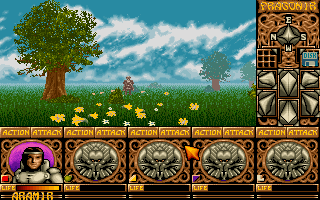
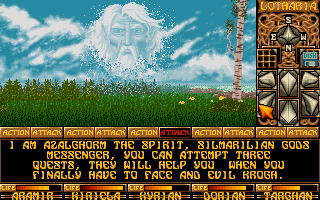
Ishar is in fact, a sequel to Crystals of Arborea (1991), where Jarel and his companions defeated Morgoth (yeah, Arborea did draw a lot from Silmarillion), now after Jarel death, the land fall o chaos and a new enemy — Krogh — emerges, he build the temple of “Ishar” and threat the land Keldoria, and up you (Aramir) to stop him.
One the very first you are going to notice is that the game does use a curious saving system, where you must “pay” to save, which while might appear a way to avoid save-scumming, it does annoy you more early on, where you have almost no money and even resting and get food can cost a lot (weapons, armor and training cost even more), so its easy to get stuck. The only way around is farming enemies over and over again. Later on, you have enough gold that this does not matter anymore.
You do start with a single character (Aramir) and you can meet people that might join your party which can be up to five characters. But that this first character isn´t essential, he can die (or leave) and you can continue playing. Some classes can have unique abilities, like locks pick, first aid and orientation (but in my experience I don´t remember ever using or need lock picks).
Most of characters you are either in taverns or around the world, at one point you can even (and in fact you need to) recruit Krogh´s mother! (she is essential to finish the game, because of her “anti-Krogh spell” but when you first find her she was transformed in to a pig by Krogh)

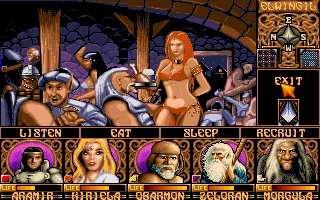
One of unique features in Ishar (and in later games of the franchise)the way the game work the relationship between the party members and how affect them. Alignment, race and class might affect how each character react when you try to recruit or dismiss someone, because you can´t just order that, the party does vote if they want that or not, they even can start to attack each other because alingment differences,
The manual say that some characters might refuse to fight some monsters (I didn´t see that when I played) and even claims that characters might develop friendships, but this isn´t very clear in this works ingame, because the manual does not describe the system in detail and while ingame you can visit a npc which is a “psyco-analyst” he just gives a short description of how things are going in the party.
Saddly, this system can cause a few problems, because at some points in the game you do need to change characters in order to recruit vital ones, but you might be unable to do it, since your party refuse to let anyone go and this can be made worst because you might don´t realize that you need this or that npc. The only way around is let someone die or maybe order one character to attack other, often leading the party to civil war. Also, once someone leave the party they will vanish forever (hope you don´t leave any quest items with this character).
This all mean, that while there is a lot of character that can join your party, most time you won´t or can´t change the party much. Maybe the game expect you to play with mixed alignment party, but since the first different alingment character that you meet in the very first steps will leave the party in the first night of rest taking some gold with him you might not try that again, given how little gold there is in the start.
The game also features a alchemy crafting system and in many parts of the game you do must have the right potions and ingredients to continue on, the formulas came in the manual but not the description of what each one does. Now I am not really sure, at least I can´t remember by memory, but I think that either in this game (or in the next) there was a translation mistake (I think the game was first in French) ingame and one potion have the wrong name.
There was a couple of settlements in the world and some more “standard” towns in the game (I mean with separated map), where you could find some hints, buy ingredients, weapons and armor and visit a trainer, where you can improve attributes, skills and even learn spells (each region had different spells you can learn, meaning a lot of back and forth to find the right spells).
One of Ishar issues, that was maybe common in a lot of other early and ambitious crpgs, is that while it sometimes it was what today we would call a open world or even a sandbox (if we stretch the term to the limit), it fact it required you to do a very specific set of things that no one really tell you and the connections can be very vague, the lack of explanation often make things very confusing (you can hear rumors in taverns, but I confess never did that or remember learned anything useful). Most time this happen due technical limitations of the period, and to be fair and clear, Ishar I doesn´t suffer from that so much as the next game, save a few points which I describe next, the game pace and progression is fine (and a lot of times you meet npc which will hint what to do).
- At one point you need to collect several tablets, but one of them is cursed, unless you have a potion (maybe a spell), your party might die, the problem is that you might have no idea at all of this curse or what potion you do need. So you might pick the tablet without knowing any of this and see your character dying without knowing why.
- One of the most most vague moments, which isn´t essential, but useful: In certain place in the map you do find a magic sword (which is in fact Jarel´s sword) stuck in a stone. The problem is, that while you do choose a character to do it so, what the game does take in account the total strength of the whole party which most be above a certain minimum (62 if memory didn´t fail me), but the game does not explain that, instead, a failed attempt to remove the sword just wield a “you are a bit wet behind your ears”.
- The maybe most annoying (or eye rolling) quest involves going in a city, which was take over by orcs, to rescue a elven woman, daughter of one of the Jarel´s companions. First problem, hope you have a free slot in your party, because you need. Second once she is in, one of you male party member will refuse to let here go because he falls in love with her (and vice versa, game dialog kind suggest that she fell in love with him too), making impossible to complete the quest, unless either you get rid of him (by letting him die or order the party to kill him) or by making a potion to dispel (again you might not even realize that this option exist). Another option is having a all woman party, which avoid the issue. Off course you still can try to kick that character of the party or having one member to attack another that most likely kill everybody…
Combat is you average third person perspective in early crpg, you can equip you character with weapon and choose the over position of each party member (the game does have a system of ranks, and what weapon can be used in each rank) and click on each weapons(which have different cooldowns) to attack or use spells. Late in the game magic does became really powerful (Repulse, Lightning, Fireball will be the most used) and you need certain spells at key moments.
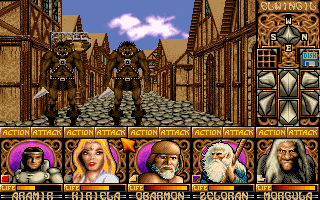
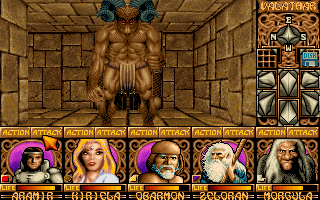
The difference however, is the game does have physical and mental energy, which is depleted as you fight or cast spells, to replenish you need either food or spells, which might mean make trips forth and back from dungeons.
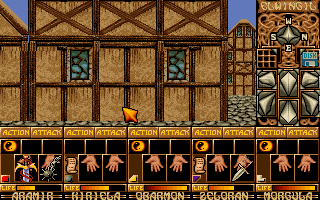
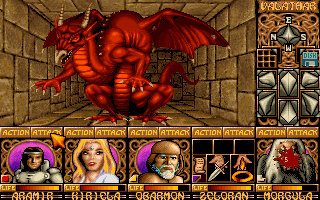
One problem on its interface it that spell effects can´t be very vague and there is very little feedback, so you can be hit by a spell and not even notice not even know what is going on. Per example, at one point while playing, I was hit by the spell “Inversion” which change the character alignment, which made my character to attack each other, but it did take a while for me to realize what is going on. I only noticed the attacks and the small icon in form o “ying-yang”, I had to check on GoG forum to realize that was the effect of the Inversion spell and I had to cast it again (thankfully one of my characters know it) to reverse this (note: the manual does not explain the spell effect or its icons, for that you must look in Ishar II manual).
The artwork and overall visual design have much of the late 80 and 90 fantasy art, but had quite unique flavor, specially in the character portrait design (each one try to have a distinct look), the rest of the characters: like enemies and npc are your average.
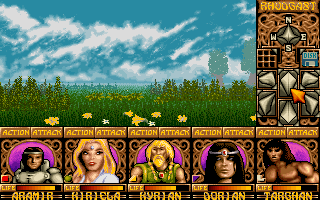
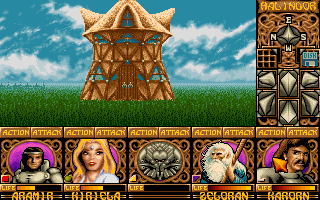
The world itself is vast and majority of the time is spend outdoors in rather large open spaces (save a few dungeons and cities), you move around it similar way to many old crpgs, like Wizardry and Might and Magic (and in more modern example, think of Legend of Grimrock), in a third person perspective which you move by squares. The interesting thing is that the game art try to make this squares appear more seamless and more natural (instead of of using the same texture over and over), which mean that each region is try to be quite unique (each having a name), most of them are linked by land but there is a lot portals to get around more easily.
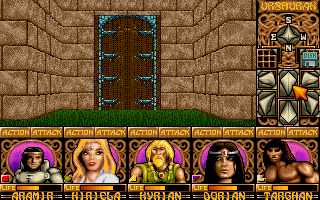
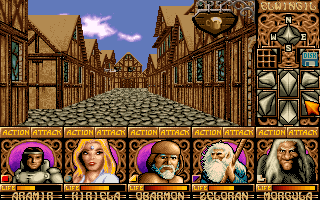
Still, there is a couple of place, mostly towns and a few open places where navigation can be really trick, because is very easy to get lost.
Ok, so far all I have just described the game and some of it´s system and the issues…So how the game does feel? (I know it is very strange to make this kind of division, but still…)
For one thing, Ishar, while in surface look like many other crpg of the period (Might and Magic, Eye of the Beholder, Wizardry) does have it´s own flavor to, that is rather hard do explain, because isn´t not anything deep or complex, maybe the best way to say, is that Ishar, is a simple fantasy with a clear story, and I don´t mean this in a negative way, because there is a charm in simplicity. In Ishar you are tasked with defeat Krogh, how exactly he is very vague and what Krogh did or is doing is even more vague, all the manual (and I will quote some parts of it) say that he was “shady and powerful figure” once an adventurer and mercenary which managed to rise to power after Jarel death and chaos that followed and he “seek the return of darkness”. But still, it kind works, because again in comparsion with other titles of the period (compare it to Wizardry and Might and Magic with their themes that mixed sci-fi and fantasy or Eye of the Beholder that had a more AD&D themes), it´s quite different if you join it with the party system and some of its other elements (isn´t much until Baldur´s Gate, at least in the west, that you got such ideas for npcs reacting due their alignment).
Small curiosity: let´s go back a bit, remember how in Crystals of Arborea, the main enemy was Morgoth? there is in Ishar the kind same idea that was Lord of Rings, where a greater evil is replaced another one, which isn´t so powerful, but still dangerous (the Morgoth to Sauron), except that Korgh is nowhere near Sauron in power (at least from what the game hint and from what I remember), as he is more some kind of warlord (and maybe a cult leader too) that manages to rise to power, but that might have some ties with Morgoth (I can´t remember if the game says that or suggest).
That is it for now, hope you all like it. Next stay tuned for Ishar II — The Messengers of Doom!
About the game:
- Release date: 1992
- Developer: Silmarils
- Plataforms: PC, Amiga, Macintosh, Atari
- Version I played: Ishar Compilation from Good Old Games (http://www.gog.com/game/ishar_compilatio
Log in to comment